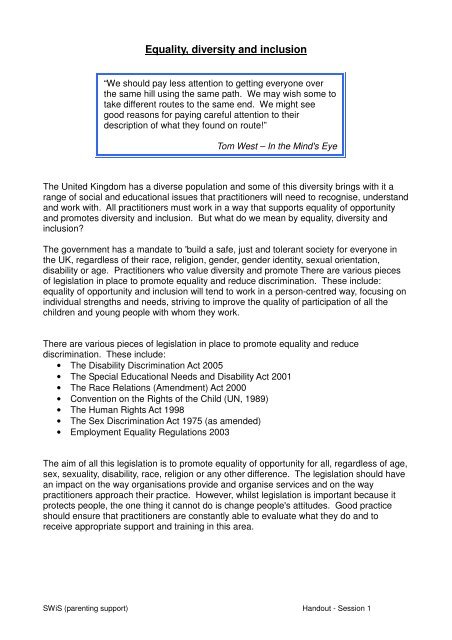Equality, diversity and inclusion - Northumberland Extended Services
Equality, diversity and inclusion - Northumberland Extended Services
Equality, diversity and inclusion - Northumberland Extended Services
You also want an ePaper? Increase the reach of your titles
YUMPU automatically turns print PDFs into web optimized ePapers that Google loves.
<strong>Equality</strong>, <strong>diversity</strong> <strong>and</strong> <strong>inclusion</strong><br />
“We should pay less attention to getting everyone over<br />
the same hill using the same path. We may wish some to<br />
take different routes to the same end. We might see<br />
good reasons for paying careful attention to their<br />
description of what they found on route!”<br />
Tom West – In the Mind's Eye<br />
The United Kingdom has a diverse population <strong>and</strong> some of this <strong>diversity</strong> brings with it a<br />
range of social <strong>and</strong> educational issues that practitioners will need to recognise, underst<strong>and</strong><br />
<strong>and</strong> work with. All practitioners must work in a way that supports equality of opportunity<br />
<strong>and</strong> promotes <strong>diversity</strong> <strong>and</strong> <strong>inclusion</strong>. But what do we mean by equality, <strong>diversity</strong> <strong>and</strong><br />
<strong>inclusion</strong>?<br />
The government has a m<strong>and</strong>ate to 'build a safe, just <strong>and</strong> tolerant society for everyone in<br />
the UK, regardless of their race, religion, gender, gender identity, sexual orientation,<br />
disability or age. Practitioners who value <strong>diversity</strong> <strong>and</strong> promote There are various pieces<br />
of legislation in place to promote equality <strong>and</strong> reduce discrimination. These include:<br />
equality of opportunity <strong>and</strong> <strong>inclusion</strong> will tend to work in a person-centred way, focusing on<br />
individual strengths <strong>and</strong> needs, striving to improve the quality of participation of all the<br />
children <strong>and</strong> young people with whom they work.<br />
There are various pieces of legislation in place to promote equality <strong>and</strong> reduce<br />
discrimination. These include:<br />
• The Disability Discrimination Act 2005<br />
• The Special Educational Needs <strong>and</strong> Disability Act 2001<br />
• The Race Relations (Amendment) Act 2000<br />
• Convention on the Rights of the Child (UN, 1989)<br />
• The Human Rights Act 1998<br />
• The Sex Discrimination Act 1975 (as amended)<br />
• Employment <strong>Equality</strong> Regulations 2003<br />
The aim of all this legislation is to promote equality of opportunity for all, regardless of age,<br />
sex, sexuality, disability, race, religion or any other difference. The legislation should have<br />
an impact on the way organisations provide <strong>and</strong> organise services <strong>and</strong> on the way<br />
practitioners approach their practice. However, whilst legislation is important because it<br />
protects people, the one thing it cannot do is change people's attitudes. Good practice<br />
should ensure that practitioners are constantly able to evaluate what they do <strong>and</strong> to<br />
receive appropriate support <strong>and</strong> training in this area.<br />
SWiS (parenting support) H<strong>and</strong>out - Session 1
Supporting children with learning difficulties <strong>and</strong>/or disabilities<br />
When working with children <strong>and</strong> young people with learning difficulties <strong>and</strong>/or disabilities<br />
practitioners should focus on what people can do rather than what they can't do. The<br />
Special Educational Needs Code of Conduct (DfES, 2001) sets out fundamental principles<br />
that should be used when working with children <strong>and</strong> young people with learning difficulties<br />
<strong>and</strong>/or disabilities.<br />
Parenting workers<br />
When working with parents to support children <strong>and</strong> young people with learning difficulties<br />
<strong>and</strong>/or disabilities, you will need to be aware of the principles of the Special Educational<br />
Needs Cope of Practice <strong>and</strong> the models of disability highlighted below.<br />
The social model of disability views discrimination <strong>and</strong> prejudice as being rooted in<br />
the barriers of attitude, environment <strong>and</strong> organisation of society. The focus of work is<br />
therefore on who the child is, not on their disability. Attention is put on his/her likes <strong>and</strong><br />
dislikes <strong>and</strong> on supporting him/her to live as full <strong>and</strong> active a life as possible.<br />
The medical model of disability views disabled children <strong>and</strong> young people as being in<br />
some way deficient. IN the medical model attention is focussed on 'impairments' that<br />
the child has <strong>and</strong> tries to 'fix' them.<br />
Prejudice <strong>and</strong> discrimination<br />
Social inequalities are present in all societies in one form or another, influencing every<br />
aspect of people's lives <strong>and</strong> attitudes. This is because society is made up of individuals<br />
who hold a spectrum of values, beliefs <strong>and</strong> opinions. Some of these are based on<br />
prejudice <strong>and</strong> discrimination.<br />
Prejudice can be defined as unfavourable opinion or feeling formed beforeh<strong>and</strong> without<br />
knowledge, thought or reason; discrimination can be defined as treating a person less<br />
favourably than others in the same or similar circumstances.<br />
There is evidence to suggest that discrimination can lead to extremely negative life<br />
consequences for children <strong>and</strong> young people. Key questions for practitioners are:<br />
• How can I ensure my practice is not discriminatory?<br />
• How can I promote equality of opportunity?<br />
• What is good practice in this area?<br />
All practitioners must underst<strong>and</strong> that there is absolutely no form of discrimination or<br />
harassment that is in any way acceptable. If a child, young person, parent or colleague<br />
behaves in a discriminatory way, the practitioner has a responsibility to challenge them –<br />
with a clear idea about why they are challenging them <strong>and</strong> how to do it as effectively as<br />
possible.<br />
Anti-discriminatory practice involves practitioners in the examination of their own values,<br />
beliefs, attitudes <strong>and</strong> expectation to ensure that they work proactively to give all children,<br />
young people <strong>and</strong> parents equality of opportunity at all times. To work in an antidiscriminatory<br />
way practitioners need to have knowledge of relevant equal opportunities<br />
legislation <strong>and</strong> what this means for their practice, as well as knowledge of their<br />
organisation's policies <strong>and</strong> codes of practice. Children, young people <strong>and</strong> parents have a<br />
SWiS (parenting support) H<strong>and</strong>out - Session 1
ight to a genuine commitment from practitioners to the concepts <strong>and</strong> practices that<br />
underpin equal rights legislation <strong>and</strong> policies, rather than tokenistic behaviours.<br />
The promotion of equality of opportunity involves respect for all people <strong>and</strong> valuing their<br />
individuality <strong>and</strong> personal circumstances. It also involves encouraging <strong>and</strong> fostering a<br />
positive learning environment.<br />
Inclusion<br />
Inclusive working is built on promoting equal opportunities <strong>and</strong> therefore antidiscriminatory<br />
practice. It means working flexibly, operating structures <strong>and</strong> systems that<br />
take into account what each individual can offer <strong>and</strong> what each individual needs. Inclusion<br />
involves a focus on ensuring that everyone has the opportunity to be engaged <strong>and</strong><br />
involved in mainstream community life. Practitioners need to be aware of <strong>and</strong> work to<br />
overcome any barriers to <strong>inclusion</strong>, because promoting <strong>inclusion</strong> <strong>and</strong> combating<br />
discrimination will:<br />
• Enhance service users' satisfaction <strong>and</strong> better meet their needs<br />
• Increase the confidence of local <strong>and</strong> diverse communities<br />
• Create a safe <strong>and</strong> inclusive environment for all<br />
• Enhance democracy <strong>and</strong> accountability<br />
• Reduce personal <strong>and</strong> financial costs.<br />
Booth <strong>and</strong> Ainscow (2000) developed an index for <strong>inclusion</strong> in which <strong>inclusion</strong> is seen as a<br />
principled approach to education <strong>and</strong> society. It is an attempt to put into action values<br />
concerned with equity, participation, respect for <strong>diversity</strong>, community, rights, compassion<br />
<strong>and</strong> sustainability.<br />
It could be argued that exclusion is a consequence of barriers to <strong>inclusion</strong>. In addition to<br />
the barriers created by undervaluing <strong>diversity</strong> <strong>and</strong> inequality of opportunity, there are many<br />
other barriers to <strong>inclusion</strong>. One of the problems is that the longer the child, young person<br />
or parent is left outside the mainstream, the more problematic the task of re-engaging <strong>and</strong><br />
reintegrating them becomes. The Index for <strong>inclusion</strong> suggests approaches to becoming<br />
more inclusive, involving three interconnected dimensions, as shown in the diagram<br />
below:-<br />
SWiS (parenting support) H<strong>and</strong>out - Session 1








